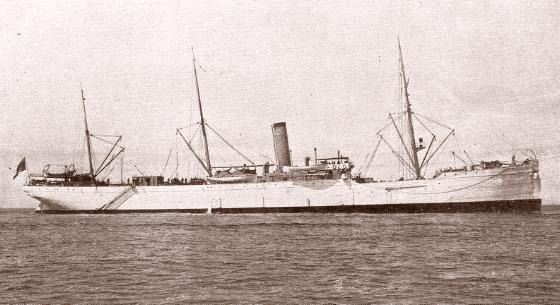


On July 22, 1901, the vessel left Cavite and steamed for New York by way of the Suez Canal. She arrived in New York on September 25, 1901. A few days later, on October 1, she was decommissioned in Boston.
In 1902 CULGOA was recommissioned and again began supply duties, this time in the Caribbean and Gulf of Mexico. On August 11, 1905 CULGOA was again placed out of commission and was actually struck from the navy rolls on May 7, 1906. A few weeks later, on June 30, she was reinstated. The vessel was recommissioned on September 12, 1907 for services with the Atlantic Fleet. CULGOA was briefly loaned to Panama Railway Company for a run with much needed beef, before joining the Atlantic Battleship Fleet and the Great White Fleet Cruise.
On the cruise, CULGOA was one of four auxiliaries to accompany the sixteen battleships. During the cruise, while on a planned supply run, she carried naval artist Henry Reuterdahl, who had been ordered away from the fleet for negative comments to the press. She also aided in wireless communications between the fleet's squadrons and brought emergency supplies to Messina, Italy, which had been ravaged by an earthquake.
Returning to the U.S. east coast in 1909, she again began normal supply duties. Between 1910 and 1918, she visited Europe once, and brought supplies to forces involved in intervention activities in Latin America.
During World War One, CULGOA made seven Atlantic passages taking supplies to Great Britain and France. On one cruise, she assisted the SS OOSTERDIJK which san after colliding with the SAN JACINTO. CULGOA rescued survivors and towed SAN JACINTO to Halifax, Nova Scotia.
In June of 1920, the vessel returned to the Pacific, steaming to Pearl Harbor. In September of the same year, she returned to the U.S.'s east coast. She was decommissioned at New York on December 31, 1921, and was sold on July 25, 1922.
ADVANTAGES/DISADVANTAGES:
This vessel would have been a god-send to the crewmen serving aboard
the ship's in Dewey's Asiatic Squadron. Refrigeration
was a new technology, and the only warship in the Asiatic that had refrigeration
was OLYMPIA. The capability would have been most
welcome.
| Classification: | AF (Store Ship) | |
|---|---|---|
| Launched: | 1889 or 1890 | |
| Commissioned: | December 3, 1898 | |
| Armament: | 0ne 6-pounder (after commissioning) | |
| Rig |
Schooner
|
|
| Contractor: | J. L. Thompson and Sons, Ltd. | |
| Length: | 346 feet, 4 inches | |
| Beam: | 43 feet | |
| Draft: | 21 feet, 9 inches | |
| Gross Tonnage | 3,325 tons | |
| Net Tonnage |
2,135 tons
|
|
| Compliment: | Crew of 122 under the command of Lt. Cdr. J. W. Carlin | |
| Speed |
13 knots
|
|
| Engine Type: | Two compound engines, 2 shafts. |
Naval History Department, Department of the Navy, Dictionary of American Naval Fighting Ships, Vol. II, Washington DC: Government Printing Office, 1963, 213-214
Hart, Robert A., The Great White Fleet - Its Voyage Around the World, 1907-1909 (Boston: Little, Brown, and Company, 1865) 51, 174, 279, 281.

